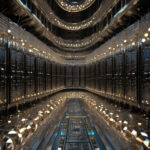US Engineers’ New Approach to Attacking Vision Systems Can Make AI See Whatever You Want
Engineers have explored a new way of attacking artificial intelligence computer vision systems. They believe that by manipulating certain aspects of the input data, they can deceive AI systems into seeing things that are not there. This novel approach, known as an adversarial attack, is raising concerns about the vulnerability of AI systems and the potential implications for various industries that rely on these technologies.
Artificial intelligence has made significant advancements in recent years, particularly in the field of computer vision. AI-powered systems can now accurately identify objects, recognize faces, and even drive cars. However, as these systems become more integrated into our daily lives, concerns about their security and reliability have also grown.
Engineers in the United States have been at the forefront of researching adversarial attacks on AI vision systems. By introducing carefully crafted perturbations to images or videos, these engineers have found that they can trick AI algorithms into misidentifying objects or perceiving nonexistent elements in the input data.
For example, by adding imperceptible noise to an image of a stop sign, researchers were able to make an AI-powered vehicle perceive it as a speed limit sign. Similarly, by slightly altering the pixels in a picture of a cat, they could make the AI system misclassify it as a dog. These subtle manipulations highlight the susceptibility of AI vision systems to external attacks and raise questions about their reliability in real-world applications.
The implications of these adversarial attacks are far-reaching. In the healthcare industry, where AI is used to analyze medical images and assist in diagnoses, a manipulated scan could potentially lead to misinterpretations and incorrect treatment plans. In autonomous vehicles, a hacked vision system could misidentify traffic signs or pedestrians, putting lives at risk. Even in security systems, where AI-powered cameras are used for surveillance, an adversarial attack could compromise the integrity of the entire network.
Despite the alarming nature of these findings, US engineers are not advocating for the abandonment of AI vision systems. Instead, they emphasize the importance of understanding these vulnerabilities and developing robust defenses against potential attacks. By studying how adversarial attacks work, researchers can improve the resilience of AI algorithms and make them more secure against manipulation.
One approach that engineers are exploring is the use of generative adversarial networks (GANs) to detect and counteract adversarial attacks. GANs consist of two neural networks – a generator and a discriminator – that work together to generate and evaluate data. By training GANs on both clean and manipulated images, researchers can teach them to identify and neutralize potential threats to AI vision systems.
Furthermore, researchers are also investigating the development of certification methods that can verify the robustness of AI algorithms against adversarial attacks. These certification techniques aim to provide guarantees about the security and reliability of AI systems, giving users confidence in their performance.
As AI continues to advance and integrate into various aspects of our lives, ensuring the security and trustworthiness of these systems is paramount. The work of US engineers in uncovering and addressing vulnerabilities in AI vision systems is a crucial step towards building more resilient and dependable artificial intelligence technologies for the future.
In conclusion, while adversarial attacks on AI vision systems present significant challenges, they also offer valuable insights into the inner workings of artificial intelligence. By addressing these vulnerabilities head-on and developing proactive defense mechanisms, engineers can strengthen the security of AI systems and pave the way for a more trustworthy AI-powered future.
engineering, artificial intelligence, vision systems, adversarial attacks, US engineers












